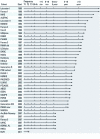European birth cohorts for environmental health research
- PMID: 21878421
- PMCID: PMC3261945
- DOI: 10.1289/ehp.1103823
European birth cohorts for environmental health research
Abstract
Background: Many pregnancy and birth cohort studies investigate the health effects of early-life environmental contaminant exposure. An overview of existing studies and their data is needed to improve collaboration, harmonization, and future project planning.
Objectives: Our goal was to create a comprehensive overview of European birth cohorts with environmental exposure data.
Methods: Birth cohort studies were included if they a) collected data on at least one environmental exposure, b) started enrollment during pregnancy or at birth, c) included at least one follow-up point after birth, d) included at least 200 mother-child pairs, and e) were based in a European country. A questionnaire collected information on basic protocol details and exposure and health outcome assessments, including specific contaminants, methods and samples, timing, and number of subjects. A full inventory can be searched on www.birthcohortsenrieco.net.
Results: Questionnaires were completed by 37 cohort studies of > 350,000 mother-child pairs in 19 European countries. Only three cohorts did not participate. All cohorts collected biological specimens of children or parents. Many cohorts collected information on passive smoking (n = 36), maternal occupation (n = 33), outdoor air pollution (n = 27), and allergens/biological organisms (n = 27). Fewer cohorts (n = 12-19) collected information on water contamination, ionizing or nonionizing radiation exposures, noise, metals, persistent organic pollutants, or other pollutants. All cohorts have information on birth outcomes; nearly all on asthma, allergies, childhood growth and obesity; and 26 collected information on child neurodevelopment.
Conclusion: Combining forces in this field will yield more efficient and conclusive studies and ultimately improve causal inference. This impressive resource of existing birth cohort data could form the basis for longer-term and worldwide coordination of research on environment and child health.
Conflict of interest statement
The authors declare they have no actual or potential competing financial interests.
Figures


References
-
- Barbone F, Valent F, Pisa F, Daris F, Fajon V, Gibicar D, et al 2004. Prenatal low-level methyl mercury exposure and child development in an Italian coastal area. Seychelles Med Dent J, Special Issue 7. - PubMed
-
- BBMRI (Biobanking and Biomolecular Resources Research Infrastructure) Homepage. 2011. Available: http://www.bbmri.eu/ [accessed 6 July 2011]
-
- Bergmann RL, Bergmann KE, Lau-Schadensdorf S, Luck W, Dannemann A, Bauer CP, et al. Atopic diseases in infancy. The German multicenter atopy study (MAS-90). Pediatr Allergy Immunol. 1994;5:19–25. - PubMed
-
- Birthcohorts.net. Homepage. 2010. Available: http://www.birthcohorts.net/ [accessed 6 July 2011]
-
- Brown RC, Dwyer T, Kasten C, Krotoski D, Li Z, Linet MS, et al. Cohort profile: the International Childhood Cancer Cohort Consortium (I4C). Int J Epidemiol. 2007;36:724–730. - PubMed

